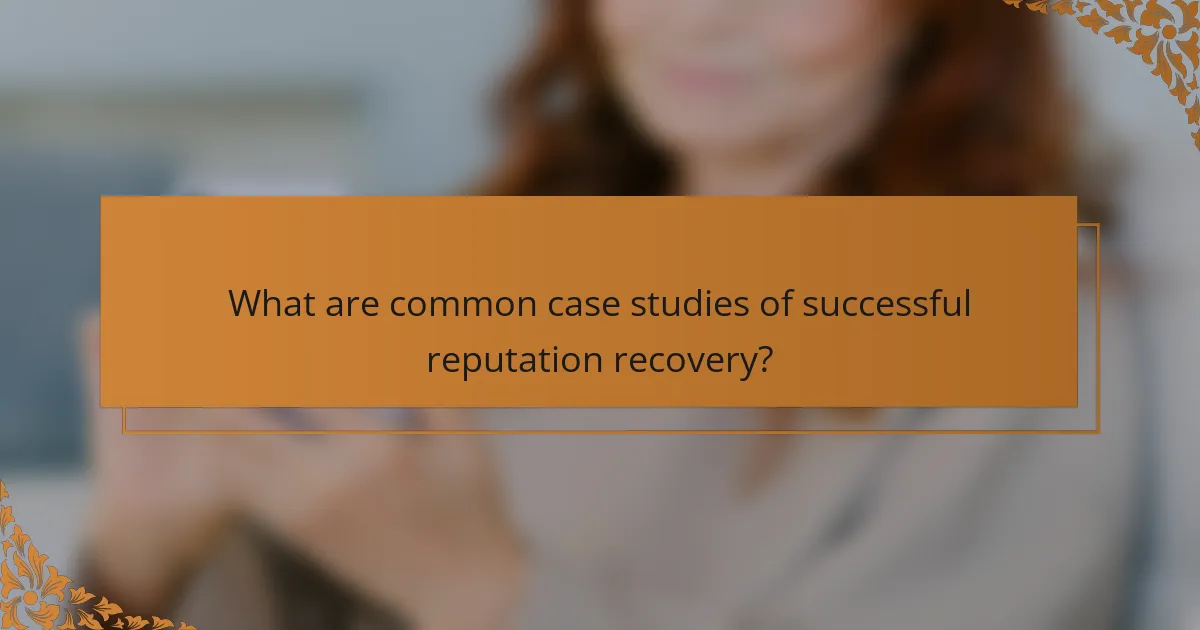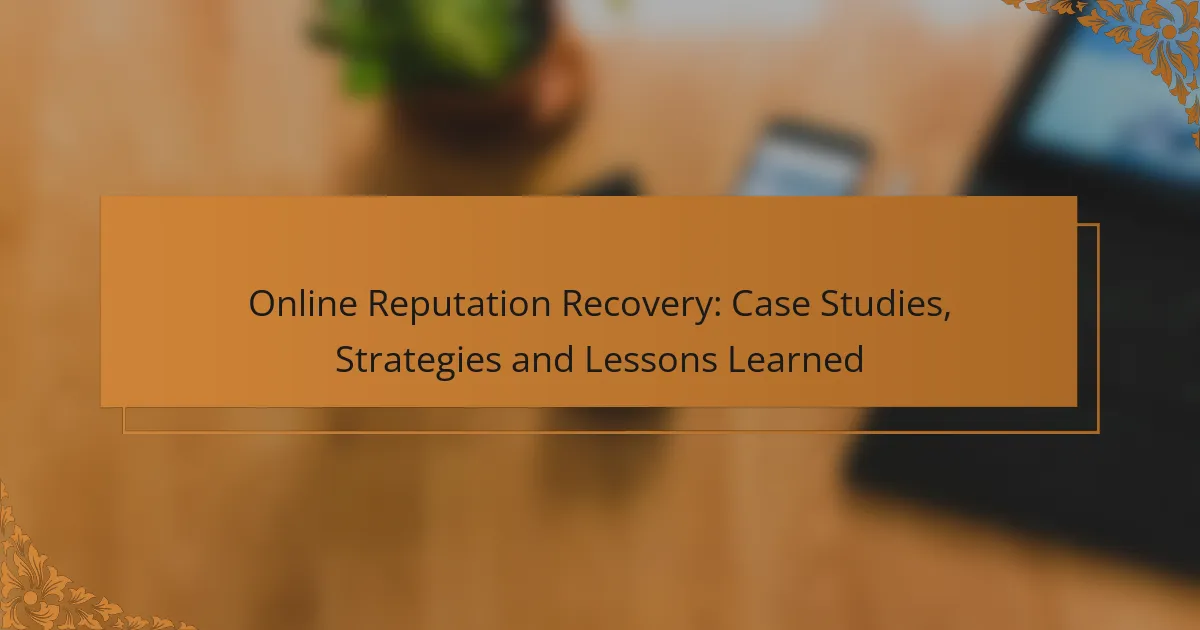Online reputation recovery is essential for businesses facing negative perceptions in the digital landscape. By employing strategies such as proactive monitoring, engaging with customer feedback, and creating positive content, organizations can effectively manage their online presence. This introduction explores case studies and lessons learned from companies like British Airways, Tesco, and Ryanair, highlighting the importance of a structured approach to rebuilding trust and improving reputation after setbacks.

What are effective strategies for online reputation recovery in the UK?
Effective strategies for online reputation recovery in the UK include proactive monitoring, engaging with customer feedback, creating positive content, and utilizing SEO techniques. These approaches help businesses manage their online presence and mitigate negative perceptions.
Proactive monitoring of online mentions
Proactive monitoring involves regularly checking online platforms for mentions of your brand. This can be done using tools like Google Alerts or social media monitoring software, which notify you of new mentions in real-time.
By staying informed about what is being said, businesses can quickly address negative comments or misinformation before they escalate. Aim to monitor key platforms such as review sites, social media, and forums relevant to your industry.
Engaging with customer feedback
Engaging with customer feedback is crucial for reputation recovery. Responding to both positive and negative reviews shows that you value customer opinions and are committed to improvement.
When addressing negative feedback, remain professional and empathetic. Acknowledge the issue, offer solutions, and invite the customer to discuss further offline. This approach can turn a dissatisfied customer into a loyal advocate.
Content creation for positive visibility
Creating positive content helps to push down negative search results and enhance your online image. This can include blog posts, articles, and social media updates that highlight your brand’s strengths and values.
Consider sharing customer success stories, case studies, or informative content that positions your brand as an industry leader. Regularly updating your content can also improve your site’s SEO, making it more likely to appear in search results.
Utilizing SEO techniques for reputation management
SEO techniques are essential for managing your online reputation. Focus on optimizing your website and content with relevant keywords that reflect your brand positively.
Additionally, ensure that your online profiles are complete and up-to-date, as this can improve visibility in search engine results. Consider building backlinks from reputable sites to enhance your authority and push down negative content.

How can businesses implement a reputation recovery plan?
Businesses can implement a reputation recovery plan by first assessing their current standing, setting clear recovery goals, and developing a strategic response. This structured approach helps organizations effectively manage and improve their online reputation after a setback.
Assessing current reputation status
To assess the current reputation status, businesses should conduct a thorough analysis of online mentions, reviews, and social media sentiment. Tools like Google Alerts, social listening platforms, and review aggregators can provide insights into public perception.
It’s essential to categorize feedback into positive, negative, and neutral to understand the overall sentiment. Regularly monitoring these metrics allows businesses to identify trends and areas needing improvement.
Setting measurable recovery goals
Setting measurable recovery goals involves defining specific, achievable targets that align with the overall reputation recovery strategy. Goals might include increasing positive reviews by a certain percentage or improving response times to customer inquiries.
Using the SMART criteria—Specific, Measurable, Achievable, Relevant, Time-bound—can help ensure these goals are practical. For instance, aiming for a 20% increase in positive reviews within six months provides a clear benchmark for success.
Developing a response strategy
Developing a response strategy requires crafting tailored responses to negative feedback and proactively engaging with customers. Businesses should create templates for common issues while ensuring responses feel personal and sincere.
Additionally, it’s vital to train staff on handling complaints effectively and maintaining a consistent brand voice across all platforms. Regularly reviewing and updating the strategy based on feedback and results will enhance its effectiveness over time.

What are common case studies of successful reputation recovery?
Successful reputation recovery often involves strategic actions that address public concerns and rebuild trust. Companies like British Airways, Tesco, and Ryanair have implemented specific strategies to effectively manage and recover their reputations after facing significant challenges.
Case study: British Airways
British Airways faced a major reputation crisis following a significant data breach that compromised customer information. The airline responded by promptly informing affected customers, offering compensation, and enhancing their cybersecurity measures. This transparent approach helped to rebuild trust and demonstrate their commitment to customer safety.
Key steps included a public apology, regular updates on security improvements, and a dedicated customer support line for affected individuals. These actions not only addressed immediate concerns but also positioned British Airways as a more secure option in the eyes of potential customers.
Case study: Tesco
In 2013, Tesco encountered a scandal involving accounting irregularities that severely impacted its reputation. The company took decisive action by restructuring its leadership and implementing stricter financial controls. This proactive stance reassured stakeholders and helped to stabilize the brand’s image.
Additionally, Tesco launched a campaign focused on transparency and community engagement, which included initiatives to support local suppliers and charities. By demonstrating a commitment to ethical practices, Tesco was able to gradually restore customer confidence and loyalty.
Case study: Ryanair
Ryanair faced backlash over customer service issues and hidden fees, leading to a tarnished reputation. The airline responded by revamping its customer service policies, including more transparent pricing and improved communication channels. This shift aimed to enhance the overall customer experience and mitigate negative perceptions.
Ryanair also invested in marketing campaigns that highlighted their commitment to customer satisfaction and value for money. By focusing on customer feedback and making tangible changes, the airline successfully turned around its reputation and attracted new customers.

What tools can assist in online reputation management?
Several tools can effectively assist in online reputation management by monitoring your online presence and helping you respond to feedback. Utilizing these tools can streamline your efforts to maintain a positive image and address any negative content promptly.
Google Alerts for monitoring
Google Alerts is a free tool that allows you to monitor mentions of your name, brand, or specific keywords across the web. By setting up alerts, you receive notifications whenever new content is published that includes your chosen terms, enabling you to respond quickly to any potential reputation threats.
To maximize its effectiveness, create alerts for variations of your name or brand, including common misspellings. This proactive approach ensures you capture all relevant mentions, allowing you to manage your reputation more effectively.
Reputation management software like BrandYourself
BrandYourself is a reputation management platform designed to help individuals and businesses improve their online presence. It offers tools for monitoring your reputation, optimizing search results, and removing negative content from search engines.
Consider using BrandYourself if you have persistent negative search results or want to enhance your online image. The platform provides step-by-step guidance and actionable insights, making it easier to implement effective reputation management strategies.
Social media management tools like Hootsuite
Hootsuite is a comprehensive social media management tool that allows you to schedule posts, monitor mentions, and engage with your audience across multiple platforms. By using Hootsuite, you can maintain a consistent online presence and quickly address any negative comments or reviews.
Utilize Hootsuite’s analytics features to track engagement and sentiment around your brand. This data can inform your content strategy and help you identify areas for improvement in your online reputation management efforts.

What lessons can be learned from reputation recovery failures?
Reputation recovery failures often highlight the importance of proactive engagement and timely responses. Key lessons include the need to address negative feedback promptly and to have a crisis management plan in place to mitigate damage.
Ignoring negative feedback
Ignoring negative feedback can severely damage a brand’s reputation. When organizations fail to acknowledge criticism, they risk alienating customers and losing trust. A simple acknowledgment of concerns can often prevent escalation.
For instance, a restaurant that receives a poor review online should respond directly to the reviewer, offering to rectify the situation. This not only shows potential customers that the business cares but also demonstrates transparency.
Delayed response to crises
Delayed responses to crises can exacerbate the situation and lead to greater reputational harm. Organizations should have a crisis communication plan that includes immediate action steps and designated spokespeople to address issues as they arise.
For example, a company facing a data breach should inform affected customers within a few days, outlining the steps taken to secure their information. Quick and clear communication can help maintain customer trust and mitigate negative impacts.
